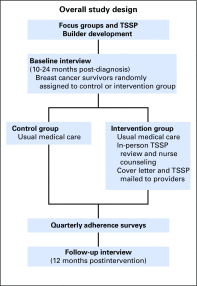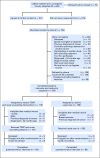Randomized Controlled Trial of Survivorship Care Plans Among Low-Income, Predominantly Latina Breast Cancer Survivors
- PMID: 28418767
- PMCID: PMC5455593
- DOI: 10.1200/JCO.2016.68.9497
Randomized Controlled Trial of Survivorship Care Plans Among Low-Income, Predominantly Latina Breast Cancer Survivors
Abstract
Purpose The purpose of this study was to examine the effects of a randomized controlled trial (RCT) of treatment summaries and survivorship care plans coupled with a nurse counseling session, primarily on physician implementation of and secondarily on patient adherence to recommended survivorship care, among a low-income population of breast cancer survivors (survivors). Methods We recruited 212 low-income, predominantly Latina (72.6%) survivors with stage 0 to III breast cancer, with an average age of 53 years, from two Los Angeles County public hospitals into an RCT of a survivorship care nurse counseling session coupled with the provision of individualized treatment summaries and survivorship care plans to patients and their health care providers from December 2012 to July 2014. One hundred seven survivors received the experimental intervention, and 105 survivors received usual care. Multiple linear regression analyses were performed to assess intervention effects on physician implementation of and patient adherence to recommended survivorship care. Scales that served as covariables were Knowledge of Survivorship Issues, Perceived Efficacy in Patient-Physician Interactions, and Satisfaction With Care and Information. Results Survivors in the intervention group reported greater physician implementation of recommended breast cancer survivorship care, for example, treatment of depression or hot flashes, than did those in the control group (adjusted difference, 16 ± 5.3; P = .003). Baseline Satisfaction With Care and Information was positively associated with physician implementation (coefficient, 5.2 ± 2.2; P = .02). Being married/partnered (-11.8 ± 4.0; P = .004) and age (-0.5 ± 0.2; P = .028) were negatively associated with patient adherence. Conclusion To our knowledge, this is the first RCT of survivorship care plans to show benefits in clinical outcomes, in this case, showing increased physician implementation of recommended breast cancer survivorship care in the intervention group, compared with the control group.
Figures
References
-
- DeSantis CE, Lin CC, Mariotto AB, et al. Cancer treatment and survivorship statistics, 2014. CA Cancer J Clin. 2014;64:252–271. (NIH NCI reference) - PubMed
-
- Hewitt M, Greenfield S, Stovall E. From cancer patient to cancer survivor: Lost in transition. National Academies Press; Washington, DC: 2006.
-
- Ries LAG, Melbert D, Krapcho M, et al (eds): SEER Cancer Statistics Review, 1975-2005. https://seer.cancer.gov/archive/csr/1975_2005/
-
- Mayer DK, Shapiro CL, Jacobson P, et al. Assuring quality cancer survivorship care: We’ve only just begun. Am Soc Clin Oncol Educ Book. 2015:e583–e591. - PubMed
Publication types
MeSH terms
Grants and funding
LinkOut - more resources
Full Text Sources
Other Literature Sources
Medical



